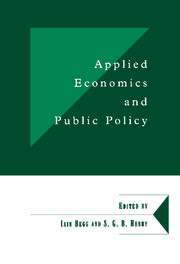Book contents
- Frontmatter
- Contents
- List of figures
- List of tables
- List of contributors
- Foreword
- 1 Introduction
- Part One MODELLING AND FORECASTING METHODS
- 2 Large-scale energy–environment–economy modelling of the European Union
- 3 Measurement errors and data estimation: the quantification of survey data
- 4 Social accounting matrices and applied general equilibrium models
- 5 The development of econometric methods at the DAE
- Part Two COMBINING DATA AND ANALYTIC TECHNIQUES
- Part Three USING MODELS TO GUIDE POLICY
- Bibliography
- Index
4 - Social accounting matrices and applied general equilibrium models
from Part One - MODELLING AND FORECASTING METHODS
Published online by Cambridge University Press: 06 July 2010
- Frontmatter
- Contents
- List of figures
- List of tables
- List of contributors
- Foreword
- 1 Introduction
- Part One MODELLING AND FORECASTING METHODS
- 2 Large-scale energy–environment–economy modelling of the European Union
- 3 Measurement errors and data estimation: the quantification of survey data
- 4 Social accounting matrices and applied general equilibrium models
- 5 The development of econometric methods at the DAE
- Part Two COMBINING DATA AND ANALYTIC TECHNIQUES
- Part Three USING MODELS TO GUIDE POLICY
- Bibliography
- Index
Summary
Introduction
The use of social accounting matrices (SAMs) to record all of the transactions that take place in a national economy during one year has a distinguished ancestry. This ancestry can be traced back at least as far as Quesnay's (1759) Tableau économique. (See Studenski, 1958 and Stone's 1986 Nobel Memorial Lecture for histories of social accounting.) In the twentieth century, social accounting has been heavily influenced by the work on national income accounts by Kuznets (1937) and that on input–output matrices by Leontief (1941). The development of SAMs as they are used today began with the work by Meade and Stone (1941) for the Economic Section of the British Cabinet Office, which developed the first logically complete set of double-entry national income accounts. Subsequent work by Stone (1947) resulted in the conventions for social accounting embodied in the United Nations' (1953, 1968) system of national accounts and currently used throughout the world.
The development of social accounting went hand-in-hand with the development of planning models that used these data. Indeed, Meade and Stone's (1941) original work was meant to provide data to aid in implementing Keynes's (1940) proposals for funding Britain's war effort during the Second World War. Stone's later work on social accounting in Britain provided data for the Cambridge Growth Model at the Department of Applied Economics. Indeed, in the hands of some users, SAMs have become economic models in and of themselves, with spread-sheet type relationships between entries.
- Type
- Chapter
- Information
- Applied Economics and Public Policy , pp. 59 - 87Publisher: Cambridge University PressPrint publication year: 1998
- 3
- Cited by

